Potting soil is vital to your container garden and raised beds. Whether you’re gardening indoors or outdoors, you need excellent quality potting soil to ensure your plants get the best growing environment.
As you plan this year’s garden, you may be looking at your leftover unopened potting soil from last year and wondering if it has an expiration date. Do you need to get fresh soil, or can you use your old potting mix?
The short answer is…it depends! You’re probably okay to use your old, unused soil, but you need to look out for signs your potting soil is bad and you may need to amend it a little so you can have healthy plants. Let’s take a look.
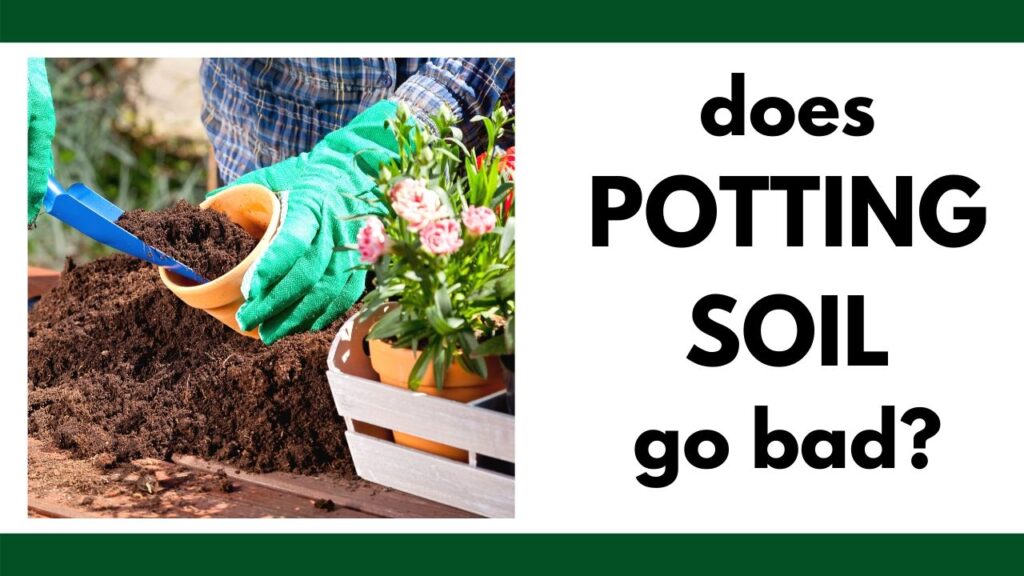
This post includes affiliate links. If you make a purchase using one of these links, Together Time Family will receive a commission at no additional cost to you.
Please note that the information in this post deals with old, but unused potting soil. Please visit this post for information about how to reuse potting soil.
Table of Contents
What are the ingredients in potting soil?
Before getting into the signs your potting soil is bad, we need to look at potting the main ingredients in potting soil. Potting soil is typically a “soil-less” growing medium because it’s not truly soil like your garden soil. Potting soil is usually made from a combination of ingredients such as:
- Perlite
- Vermiculite
- Peat moss
- Coconut coir
- Slow-release fertilizer
- Pine bark
Each of these ingredients performs a specific function to help your new plants thrive:
- Perlite is those little styrofoam ball looking things in your potting mix. It doesn’t hold water, but it keeps the mix lightweight and aerated. This helps the roots of the plant develop and thrive.
- Vermiculite also helps with aeration, but can hold water and improve soil moisture levels.
- Peat moss and coconut coir are used to hold water.
- Slow-release fertilizer brings your plants enough nutrients to last the growing season.
- Pine bark breaks down slowly. It helps provide good drainage.
Here I am, holding a great big bag of perlite. It’s very lightweight, which is important for preventing root rot and encouraging root growth.
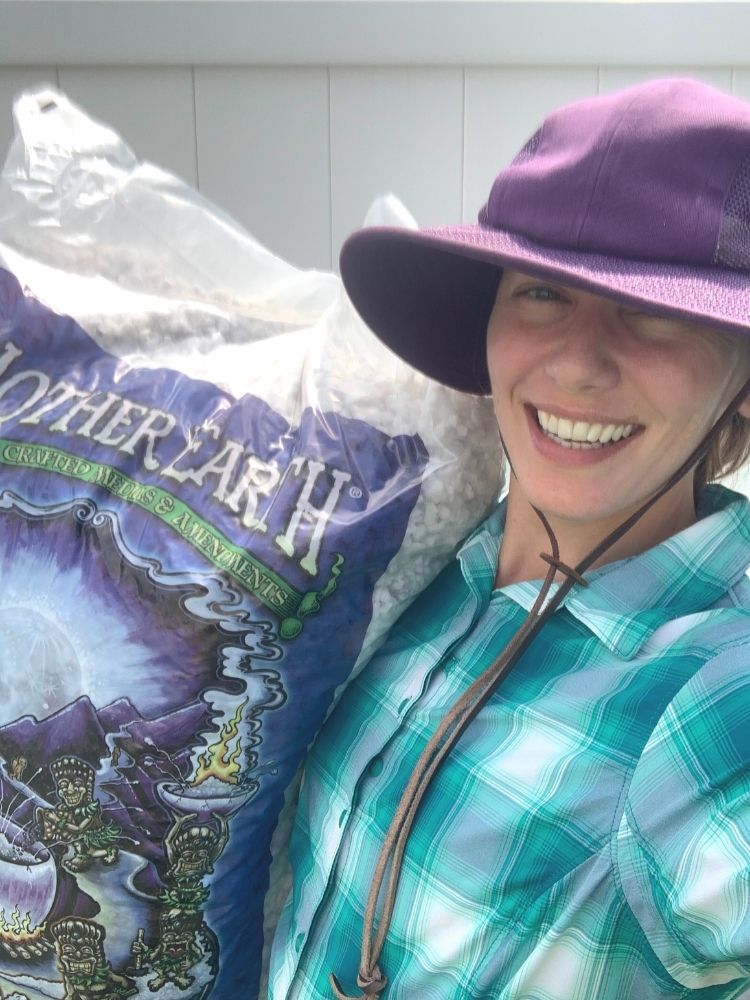
Most potting soil mixes contain peat moss, which tends to break down quickly and become compacted. This can affect the quality of the soil if you’re hoping to use old mix instead of buying new potting mix. Don’t worry – you can fix this problem and get your old soil back into good condition! I’ll show you how after we look at signs your potting soil should be tossed in the compost pile.
Does potting soil go bad? (Telltale signs)
Yes and no. Potting soil can go bad but normally it doesn’t if it’s unused and if you’re willing to do a little potting soil rejuvenation. Even after several years of sitting around, old potting soil can be salvaged and used.
Some websites will tell you that potting soil goes bad and give you and laundry list of reasons to toss your old potting soil. I believe in gardening in an eco-friendly manner that’s as easy on your bank account as possible. That’s why I recommend hanging on to your old potting soil and fixing it up.
In short, potting soil mostly doesn’t go bad unless it fulfills any of the following criteria:
- It has a bad smell
- It has any insects around it continuously
- It is infected through some disease
- It is dense and compacted
Luckily, these issues are fairly easy to fix at home.
Potting soil is perfectly fine to use as long as it doesn’t show any of these signs of bad potting soil. If you’re new to gardening, it may be hard for you to judge whether or not your potting soil is healthy and safe to use. Let’s look at the issue in more depth.
Potting soil is perfectly fine to use as long as it doesn’t show any of these signs of bad potting soil. If you’re new to gardening, it may be hard for you to judge whether or not your potting soil is healthy and safe to use. Let’s look at the issue in more depth.
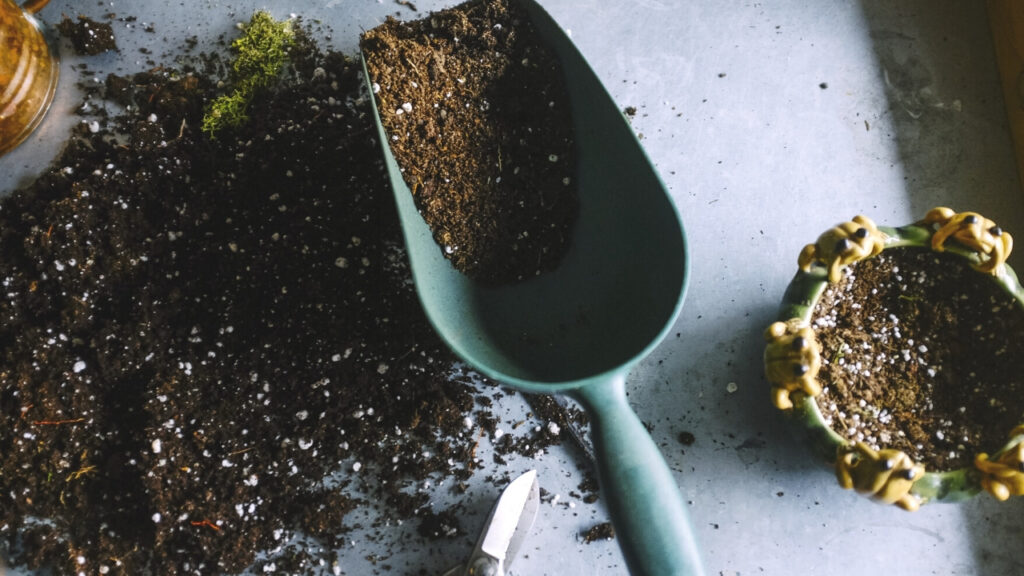
Can I use old potting soil?
You may see differences in the growth of your plants if you use old potting soil. Even if you stored the soil properly, you may see changes in the following features of the soil:
- Nutrient levels (affecting plant growth)
- Moisture
- Texture
Nutrient levels will gradually decrease over time when potting soil is stored. This is easy to fix by adding new fertilizer or organic material, such as compost.
This doesn’t mean that the potting soil is unusable, it just means that it will affect the plants just a little differently than perfectly new potting soil would. You can correct this by adding nutrients to your old potting soil. We’ll look at this more in a moment.
If you have an old bag of potting soil stored on your shelves, you can count on the opened bagged soil preserving itself for about 6 months before it starts degrading. Unopened bags can last one or two years. Check your bag for specifics – it may have a best by date.
How can I tell if my potting soil is bad?
Here are three ways you can check if your potting soil has gone bad. If your soil fulfills any or all of the following conditions, it has gone bad. If it has gone bad, you should see how to make it usable again. Fortunately for you, we already cover that here.
How can I tell if my potting soil is bad?
Here are four ways you can check if your potting soil has gone bad. If your soil fulfills any or all of the following conditions, it has gone bad.
Foul odor or bad smell
The easiest way to check if your soil has gone bad is to smell it. A decomposing, rotten smell indicates that bacteria and fungi have been breaking down the components of your potting soil. This doesn’t necessarily mean your potting soil is inherently dangerous to use, but it may not be able to provide ideal conditions for plant growth.
If this smell bothers you, you can spread the soil out on a plastic tarp in the sun on a dry, sunny day. The sunshine will kill the bacteria and you can easily use it once it is all dry.
This process will also kill beneficial soil microbes. Most potting soils do not have intentionally added beneficial soil microbes, but some more speciality ones do.
Adding beneficial microbes back to your soil is easy. I cultivate my own following the JADAM method, but you can also purchase humic acid with beneficial microbes in products like Organic Rev or EM-1.
Whether or not your potting soil originally had beneficial microbes, adding them can help your plants thrive. I prefer EM-1 because it’s easy to brew your own “extension” mix so you don’t have to keep buying the product over and over again.
Insect infestation in potting soil
If you see lots of small flying insects in your soil you may have a fungus gnat infestation. Fungus gnats don’t bite and are generally seen as harmless to people. Unfortunately, they lay their eggs in soil and large numbers of fungus gnat larvae may damage your plant’s roots.
Fungus gnats live in moist soil and the larvae are usually only present in the top 1-2 inches. Allowing your potting soil to dry completely, and remain dry for several days, should kill off the gnat infestation.
Fungus gnats are attracted to the color yellow, so you can use yellow sticky trap catch adult fungus gnats. Insecticides may be used on the adult gnats, if you want to use insecticides on your soil.
I put out yellow sticky traps to help with a bug problem and there were fungus gnats stuck to the paper before I even got the trap staked into the ground! They’re somewhat unsightly and definitely low-tech, but sticky traps can work.
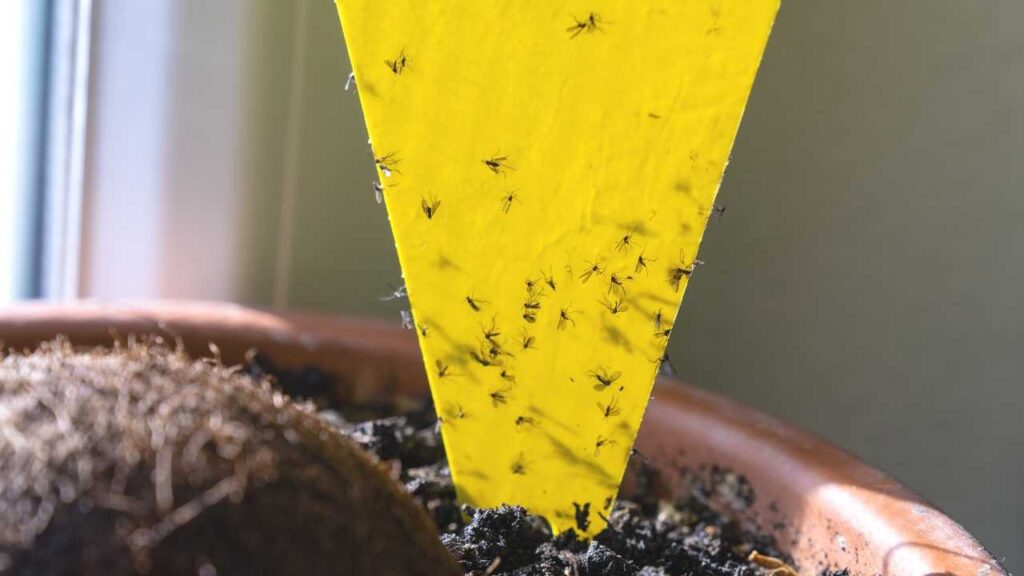
White mold on potting soil
ow if your soil has too much moisture. This tends to happen if your soil is in a bag for a long time, especially in warm weather. I’ve left a bag of potting soil in the car for a few days and opened it to find a whole bunch of mold!
You can kill off the mold by allowing the soil to dry. Spread it out in the sun and let it dry completely. Again, you’ll want to reintroduce beneficial microbes after drying your soil out in the sun.
New, bagged potting soil shouldn’t have harmful plant pathogens.
You can also bake your soil to kill mold, but this isn’t practical for large quantities of soil
Important: Never use moldy potting soil when you are growing plants from seeds. This can lead to an issues, including one called “damping off” that is cause by a soil-borne fungus of the Pythium species, that can kill seedlings.
Compacted and dense potting soil
One popular component of commercial potting soils, peat moss, decomposes quickly. This makes the soil dense and difficult for roots to penetrate. This compaction also creates poor drainage and prevents soil from retaining water well. If your old potting soil looks and feels dense and compacted, it may be suffering from decomposed peat moss.
Please see the section below about rejuvenating old potting soil to learn what to do if your soil is heavy and compacted.
How to store potting soil
Here are the things you can do to keep your extra potting soil safe for the following year. * Please note that these suggestions are mostly for unused potting soil. *
- If you are storing unopened and unused potting soil, don’t open the bags. Keep them sealed in their original bag.
- If you’ve already opened the soil bags, you can pour in the soil in a storage container. A large, opaque plastic bin works well, or you can use an unscented trash bag. Do not use an airtight container. In fact, the soil needs to breathe and a lack of oxygen can promote harmful anaerobic bacteria.
- If your bags are open, make sure the soil is dry. Excess moisture can promote mold.
- Before storing the soil, make sure the soil is completely free of any old plants, rotes, sticks and leaves. If you had a half used bag of soil sitting open, it may have gathered some detritus over the summer.
- Store your potting soil in a dark place out of direct sunlight that’s also protected from the weather.
How to rejuvenate old potting soil
Don’t just dump last season’s potting soil into your containers and get planting. The soil needs some boosting before you can use it.
If your soil is heavy and compacted, add coconut coir instead of peat moss. Coconut coir is a renewable resource and is widely considered more eco-friendly than peat moss. It also lasts longer so you won’t need to replace it each year.
Coconut coir frequently comes in dry compressed bricks, but is also available loose. It is almost always sold dry and needs to be hydrated. Combine potting soil and hydrated coconut coir in a 1:1 ratio. Your coconut coir should have specific rehydrating instructions, so read and follow the directions.
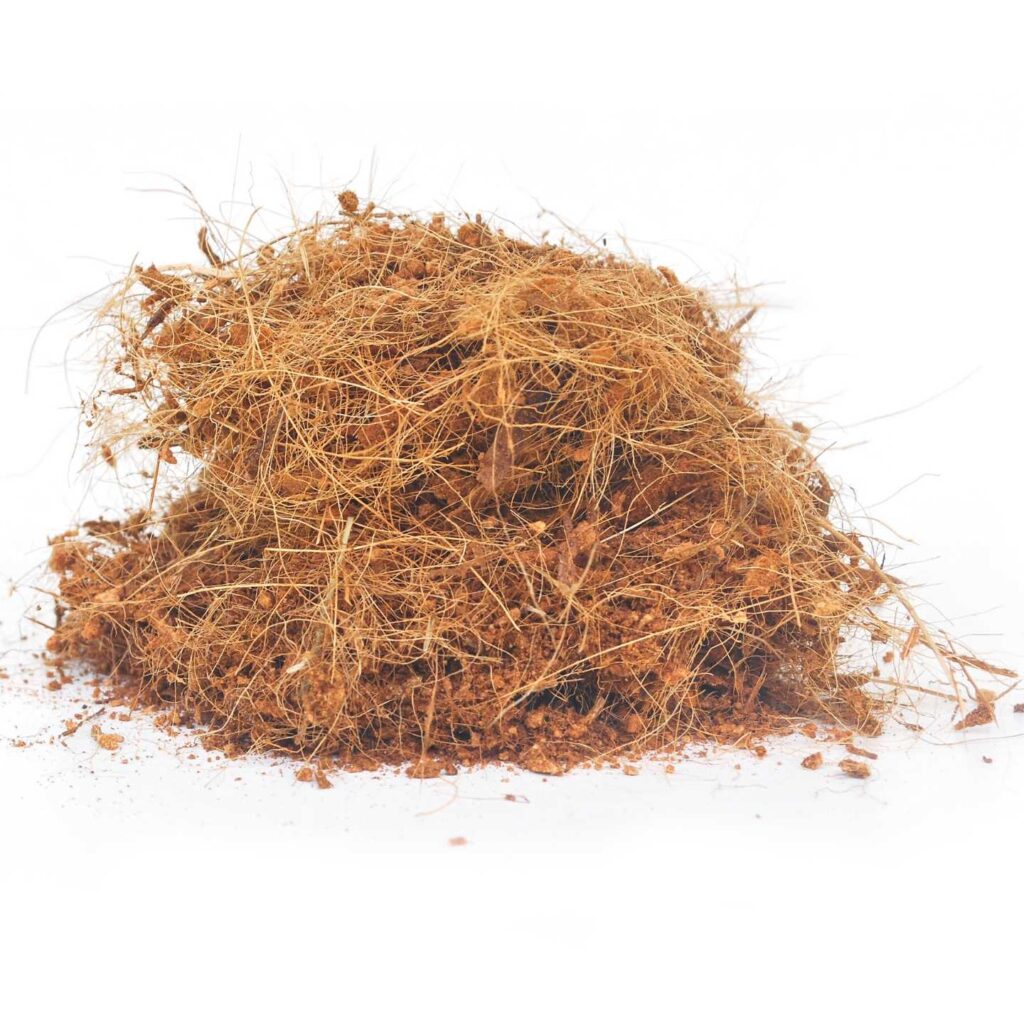
Combine potting soil and hydrated coconut coir in a 1:1 ratio. Your coconut coir should have specific rehydrating instructions, so read and follow the directions.
Table could not be displayed.Even if your potting soil was never used, it may need additional organic matter and nutrients. Compost, worm castings, and organic fertilizer are all good choices.
Specific nutrient requirements vary depending on what you intend to grow in the soil. For absolute best results, use a soil test kit and amend the soil based on your plants’ specific requirements.
And, as mentioned above, you can add beneficial microbes to your soil by cultivating your own or using a commercially available product like Organic Rev or EM-1. Soil microbes bring a host of benefits including increased nutrient uptake and resistance to disease.
If you don’t want to recharge your potting soil, you can make your own compost and soil mixture, instead. For general use in pots and containers, try a 20%-50% compost: soil mix. Compost holds moisture, so use a higher percentage if you have clay pots that dry out quickly (source).
I hope this resource has helped you save money, use your old potting soil successfully, and enjoy gardening!
Don’t lose track of this information about potting soil – Pin it to your gardening board now.
Easy Gardening Tips
Are you a beginner gardener? Or just getting serious about gardening after a few years of experimenting? These resources can help you take your gardening, and yields, to the next level!
Discover the 7 easiest vegetables to grow, and 3 to avoid, with this handy post.
Not sure which herbs you can plant together in a container? Discover what herbs to companion plant and which herbs will not grow well together with this herb planting guide!
Can you reuse potting soil? Find out when you can reuse old potting soil and when you definitely shouldn't.
Want to see this in a quick, easy format? Check out the web story.
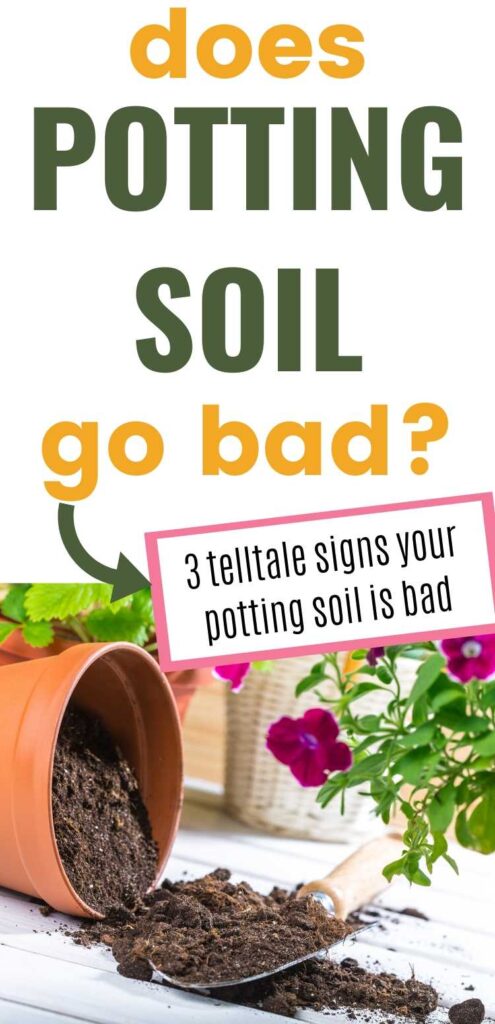
Natasha Garcia-Lopez is an avoid home-gardener and proud owner of 88 acres of land in rural West Virginia. She was a member of the Association for Living History Farms and Agricultural Museums for many years and is currently enrolled in the Oregon State University Master Gardner Short Course program so she can better assist you with your gardening questions.She holds a certificate in natural skincare from the School of Natural Skincare.

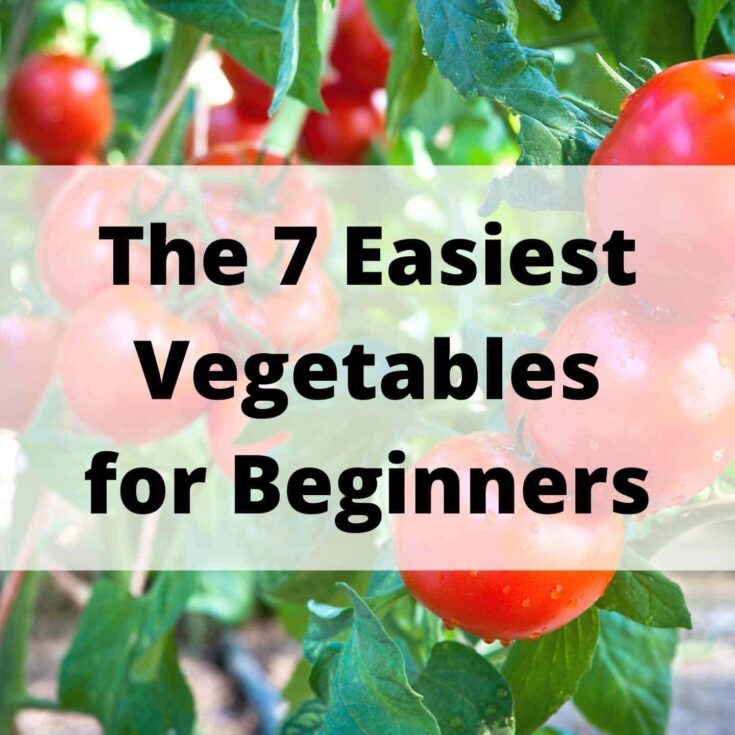
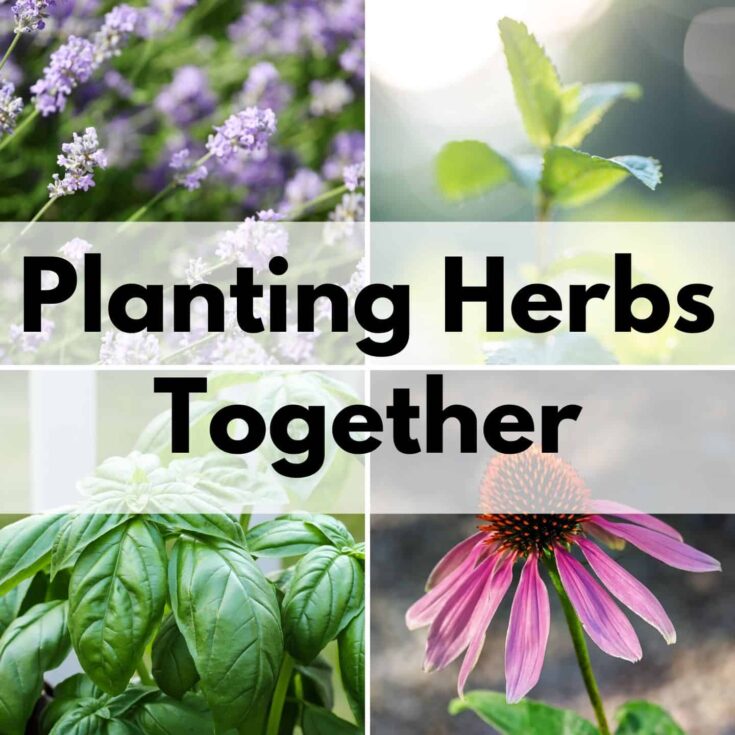
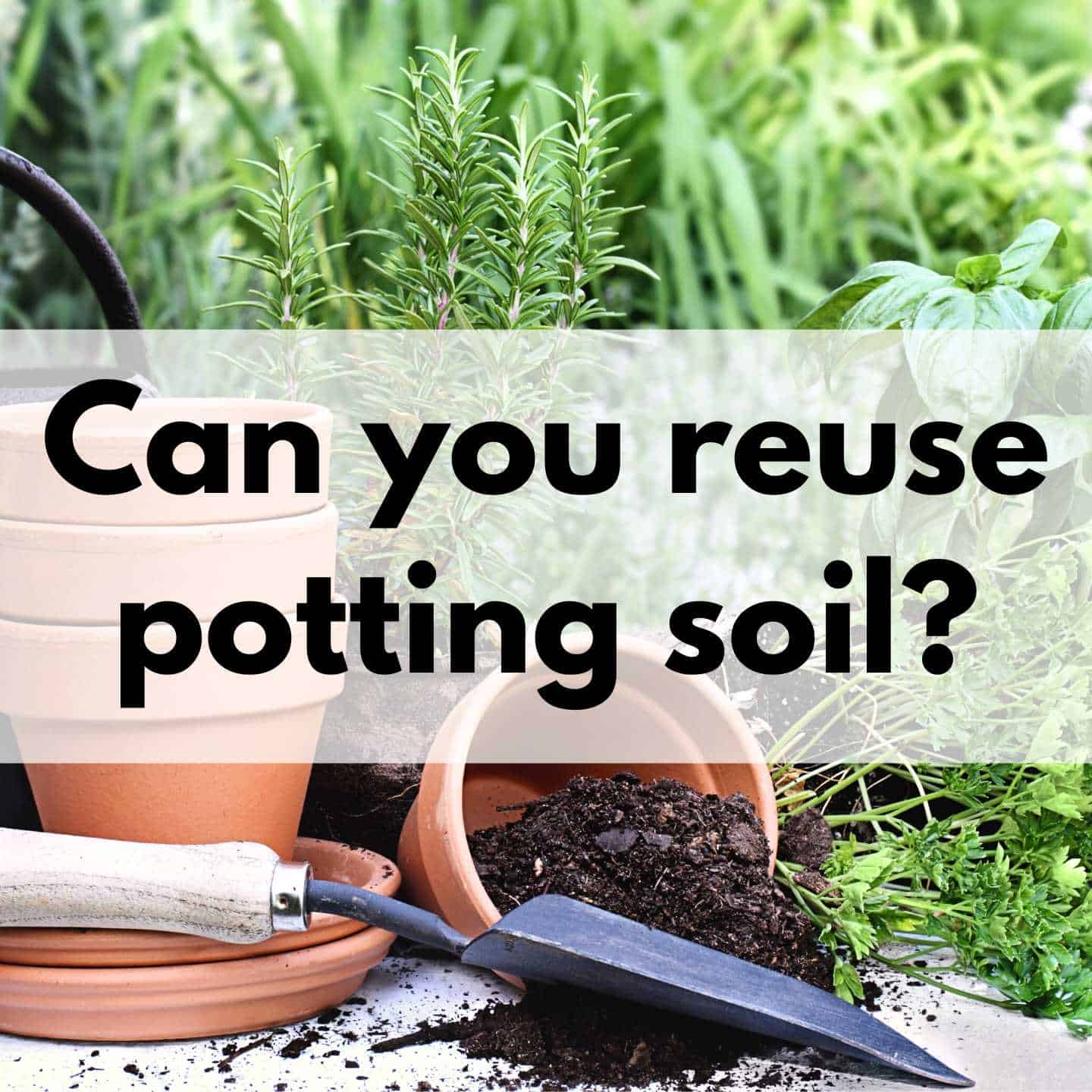

Hello,
Thanks for the info but it’s not completely accurate.
Potting soil CAN go bad, at least the beneficial microbes can die off if the soil dries out for long, such as if dried on a tarp as you suggested. As you pointed out, the sunshine WILL kill the bacteria, but also those microbes that some manufacturers specifically add to their products to enrich them.
A couple weeks ago I repotted some houseplants and left about 4 cups of soil sitting in a container. It has now dried out and I was wondering if the microbes could be revived with moisture or if it should be discarded or blended with fresh mix.
Seeking answers I hit the internet, where I found your webpage. But wanting precise answers, I called E.B. Stone, maker of Edna’s Organic Potting Soil about this very question.
No one could take my call at the time, but I later received a message on my machine from the local distributor who stated what I suspected: That drying out can kill the microbes they added, depending on how long it has been dry. If not long, adding moisture might revive some of the microbes. Soil that has been dry for an extended time can either be discarded or blended together with fresh soil and used. If left dry for a long time, it’s best to discard it and use only fresh soil.
Their advice may not apply to mixes that don’t contain added mycorrhizae.
On another note, last month I re-opened my partially-used bag of soil to find the top covered in whitish mold spores. I called the mfgr. to see if the soil was salvageable. They advised that what I was seeing was probably a result of the fungus spores they added, and that it was likely safe to use. I had my doubts, but I stirred the soil around inside the bag and used it to repot some plants. Thus far I’ve noticed no ill effects.
Your plants are fortunate you actually find and purchase potting soil with beneficial microbes! Most commercially produced soil does not have added beneficial microbes. Yes, sunlight would kill beneficial microbes, too. I should include that information in this post and will update it in the future to reflect this.
I cultivate and spray native soil microbes on my garden plants, both in the soil and in containers, following the JADAM method. It’s very simple – you can find instructions for making JADAM Microbe Solution online. If fermenting leaf mould soil isn’t your idea of a good time, Organic REV (affiliate link) is a product you can buy and use to add beneficial microbes. There are other products available, too, but I have personal experience with both of those.
In other words, you can add microbes back to your soil without purchasing new potting mix. Using a product like Organic REV will bring life back to your soil, even if it’s been dried out or sanitized in the sun.
HELP! Question about soil. Months ago I bought some soil for my tomatoes and peppers. I mixed some soil together and repotted my seedings …etc. The next days I noticed the soil had such a strong smell. I had some soil remaining in bags too, and they really stunk! It was in the summer so I thought perhaps the soil in the bags just smelt worst due to the heat and sun. After about a week or two i checked the bag that still had soil and it had turned white, so I threw them away. The soil in the pots didnt turn white.
My problem is, now i am afraid if the soil was bad in some way and if it will affect any of my produce. They will start flowering soon and honestly i am afraid to eat any. Worse part is I dont remember which pots i used that soil in because i’ve bought so many different brands in the past and mix them about.
It sounds like your soil probably got some mold or mildew. If your plants are happy and healthy, your produce should be fine to eat. Mushrooms, algae, and mildew are all fairly common in garden soil and don’t have any negative impact on the fruit as long as the fruits/vegetables aren’t moldy, too.
I bought two LARGE bags of potting soil but when I got home, they were filled with the tiniest ants I’ve ever seen and they bite hard! Anyway, I left them sealed up but outside on the edge of my garden until I got time to spread them in my raised beds I spread one after summer was over onto my strawberries and the empty bed they shared with okra. It stunk really bad – septic. I blamed it on being in the plastic bag for months and the hot, humid weather last summer. So I figured the dirt would dry out and be fine if just to add dirt with no nutrients. NOTHING has grown in the bed – it doesn’t smell but is void of life. The strawberries at the end of the bed died way back and a few have barely hung on. I haven’t used the other bag yet. Now what? Do I throw the other HUGE expensive bag away? How can I rejuvenate my raised bed row that obviously has septic dirt over it – can I or do I dig the dirt out and throw it away, also? I want to plant more strawberries and don’t know if I need to move the few I have left. After searching the internet, I couldn’t find out anything about septic dirt until I saw your post. I just need help.
I’m sorry to hear about your plants! It’s frustrating to have them damaged.
What type of potting soil was it? Did it happen to contain added manure on the label? I know people who’ve had contaminated manure kill their plants. Even if it didn’t have manure, it could have still been contaminated with herbicides. Beans and tomatoes are both very sensitive to herbicides so you can check for contamination by trying to sprout beans in some of the suspect medium and some medium that is fine. Compare the germination rates and plants. Bean plants usually have curled up leaves and trouble sprouting in the presence of herbicides.
Ants can damage plant roots if they’re in the beds, but I don’t personally know of any problems having had ants in the soil would cause for it. That doesn’t mean it’s absolutely impossible that the ants messed something up, I just haven’t heard of, or experienced, this as a problem.
If the soil got really hot, it could have thermophilicly composted in the bag and degraded it. Thermophilic compost oxidizes soil. Also, many potting soils have peat moss, which breaks down quickly anyway. On the other hand, all soil is made through decomposition. I think it’s unlikely that the soil is somehow rotten and disrupting your plants for that reason.
Maybe break open other bag and use it for a germination test? If my bed were affected so negatively by something I’d added, I would personally try to dig the soil out and remove it. I’m actually thinking about doing this with some mix I got delivered from a local nursery. I think it is completely lacking in micronutrients and I’ve found an alarming amount of debris in it, including large chunks of mirror glass!
I hope that’s at least a little bit helpful.